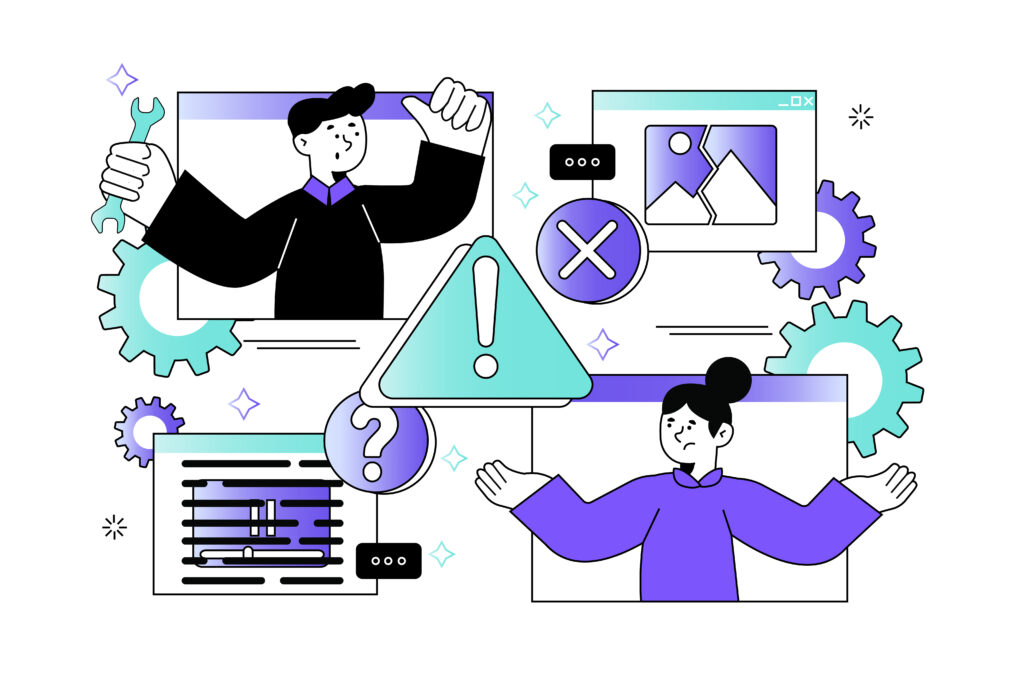Looking to create powerful applications with large language models (LLMs)? This article breaks down the essential steps in LLM application development—from pre-training and fine-tuning to using leading frameworks and optimizing performance.
Key Takeaways
– Large Language Models (LLMs) are revolutionizing various industries by enhancing automation, productivity, and efficiency, with the market projected to grow significantly by 2030.
– Key development phases for LLMs include pre-training, fine-tuning, and reinforcement learning from human feedback, which are essential for creating robust and effective applications.
– Emerging tools and frameworks like LangChain and Hugging Face Transformers are streamlining LLM application development, enabling developers to build sophisticated and scalable enterprise LLM solutions.
Understanding Large Language Models (LLMs)

Large Language Models (LLMs) are AI models designed to understand and generate human language. Prominent examples include Google’s PaLM-2, OpenAI’s GPT series, and Meta’s LLaMA 2. The global market for LLM software development companies is projected to soar from $1.59 billion in 2023 to $259.8 billion by 2030, underscoring their significant impact.
These models are expected to automate 50% of digital work, revolutionizing various fields. Key steps in their training include pre-training, fine-tuning, and reinforcement learning from human feedback.
Key Benefits of LLMs
LLMs are being integrated into numerous industries to boost productivity and streamline operations. From automating tasks to enhancing operational efficiencies, their impact is widespread. Businesses that build applications with large language models are seeing significant improvements in user satisfaction and workflow efficiency.
These models offer a plethora of key benefits, making them indispensable in the modern digital landscape.
Working Principles of LLMs
At the core of LLMs are transformers, which enable efficient natural language processing. These models leverage the self-attention mechanism to prioritize relevant words in a given context, enhancing their understanding of human language.
The encoder component converts input text into high-dimensional vectors, facilitating effective text processing and comprehension. These working principles are fundamental to the success of LLM integration and deployment services in real-world applications.
Essential Steps in LLM Development
Developing LLMs involves systematic steps to ensure effective performance. The key phases include:
– Pre-training
– Fine-tuning
– Reinforcement learning from human feedback These steps ensure the development of robust models capable of handling diverse tasks.
Let’s delve deeper into each phase to understand their significance and implementation.
Pre-training Phase
Pre-training LLMs involves several key components:
– Vast datasets from the internet, encompassing various formats like PDF, HTML, and Word.
– Use of unsupervised learning to enable the model to understand and generate natural language effectively.
– Significant computational power and time, with more parameters leading to more effective pre-training.
– Proprietary strategies such as SFT, RLHF, and DPO designed to enhance scalability, efficiency, and accuracy during training.
Text data from diverse sources ensures that the model can handle a wide range of language tasks. Extraction techniques vary depending on the data format, making data preparation a critical aspect of pre-training. This phase establishes the groundwork for creating powerful language models ready for fine-tuning.
Fine-Tuning Technique
Fine-tuning is a crucial step after pre-training, enhancing LLM performance for specific tasks. This process involves adapting models using tailored datasets that focus on the unique requirements of the target application. Domain-specific fine-tuning further improves accuracy and reduces errors in specialized fields.
Advanced techniques like Reinforcement Learning from Human Feedback (RLHF) refine model responses. Leveraging prompt engineering techniques allows developers to achieve high-quality, tailored outputs. Partnering with a llm software development company ensures fine-tuning delivers business-ready results.
Reinforcement Learning from Human Feedback (RLHF)
RLHF is implemented to ensure that LLMs align closely with human expectations, refining their decision-making capabilities. This feedback loop involves continuous assessment and adjustments based on real-user interactions, improving model output and relevance.
RLHF is particularly valuable in applications requiring nuanced understanding and accurate responses, making LLMs more effective and user-friendly.
Emerging Tools and Frameworks for LLM Application Development

Several frameworks have emerged to streamline LLM application development, enhancing the ease of building and deploying LLM-powered solutions. These tools assist with data preparation, prompt engineering, model fine-tuning, deployment, and monitoring. By leveraging these tools, companies can efficiently build applications with large language models aligned to business goals.
Let’s explore some of the most notable frameworks in this space.
LangChain Framework
LangChain is an open-source framework designed for developing applications powered by LLMs, including langchain harrison chase. It offers several key features:
– Simplifies the development process by managing components and offering pre-built tools
– Enables developers to create multi-step workflows
– Integrates various models and tools efficiently
This framework also provides memory management, API integration, and customizable components to enhance application functionality. LangChain’s capabilities make it an invaluable tool for building sophisticated LLM applications.
Hugging Face Transformers
The Hugging Face Transformers extensive library is renowned for its extensive collection of pre-trained models suitable for various natural language processing tasks. This library provides developers with a vast array of tools to build and deploy LLM applications effectively. Its comprehensive suite of models and utilities makes it a go-to resource for anyone looking to leverage the power of LLMs in their projects.
OpenLLM Platform
OpenLLM is an open-source platform that facilitates the deployment of LLMs in production environments. It supports integration with other AI models and services, enhancing the overall functionality of LLM applications. By providing a robust framework for deploying LLMs, OpenLLM ensures that developers can bring their models to market more efficiently, maintaining high performance and reliability.
Optimizing LLM Performance
Optimizing LLM performance is crucial for achieving real-world success. Pre-training is just the beginning; further optimization techniques are necessary to maximize efficiency and effectiveness. Incorporating a pre trained llm can enhance these optimization efforts.
LLMOps, which encompasses tools and practices for managing the entire lifecycle of LLMs, plays a key role in this process. Implementing model parallelization techniques can significantly improve throughput and reduce latency, ensuring that LLM applications perform at their best.
Data Preparation and Quality
Utilizing diverse and high-quality datasets is essential for improving LLM accuracy during training. Effective data preparation involves comprehensive data cleaning and transformation, ensuring that training datasets are free from bias and relevant to the task, including important data and a focused dataset.
Tokenization converts raw text into manageable units, enabling the model to learn from structured data effectively. Filtering out low-quality or harmful content further enhances dataset relevance.
Prompt Engineering Techniques
Effective prompt design significantly influences the quality and relevant responses of LLM outputs. Crafting precise prompts, such as a prompt template, is vital to guide the model in providing prompts to achieve the desired output. Utilizing specific formats and instructions can enhance the quality of LLM outputs, particularly in question answering.
Prompt engineering techniques are essential for leveraging powerful language models in various applications, particularly when leveraging powerful language models a language model.
Continuous Evaluation Methods
Continuous evaluation is crucial for maintaining LLM performance as they are updated and fine-tuned. Intrinsic evaluation methods provide insights into the linguistic accuracy of LLM outputs, focusing on metrics like BLEU scores and perplexity.
Extrinsic evaluation methods measure practical performance in real-world tasks, using benchmarks such as GLUE and MMLU. Combining both methods ensures that LLMs meet performance, reliability, and ethical standards.
Addressing Challenges in LLM Development

Developing LLMs involves overcoming several challenges, including technical, social, and ethical concerns. Key technical challenges include significant processing power and data storage requirements. Data privacy and bias management are additional hurdles. Ethical considerations involve ensuring fairness and accountability in model outputs.
Successful deployment necessitates a comprehensive guide to planning and regular evaluation.
Ethical Considerations
Ethical issues in LLM development involve concerns around fairness, accountability, and potential biases. Addressing issues like bias and misinformation is crucial for positive social impact. Biased outputs can reinforce stereotypes and inequalities, affecting public trust in AI. Integrating LLMs into society requires careful consideration of these ethical implications.
Data privacy is another critical aspect, with techniques like differential privacy enhancing protection.
Technical Hurdles
Technical challenges such as computational costs and scalability issues pose significant barriers. High computational costs during training and fine-tuning require powerful hardware and optimized algorithms. Scalability issues arise as LLM applications must manage increased loads and maintain performance across diverse environments.
Regular audits help identify vulnerabilities and ensure compliance with data protection regulations.
Social Impact
LLMs significantly influence content creation and automation, reducing time and effort. Automated article writing and editing platforms like Grammarly are becoming common. The ability of LLMs to enhance productivity and efficiency in content creation translates into more informed and engaged societies.
Their impact on social engagement and communication is profound, shaping how we interact with content.
Practical Applications of LLMs
LLMs have numerous practical applications across various industries, enhancing automation and efficiency. They are becoming integral within enterprise workflows, improving functions like customer service and human resources.
Let’s explore some of the key llm based applications of LLMs in more detail.
Conversational AI and Chatbots
Chatbots and virtual assistants powered by large language models are revolutionizing customer interactions by providing human-like experiences. These tools leverage natural language processing and text generation capabilities to facilitate seamless conversations. For instance, Zendesk uses LLMs to power AI-driven customer support features, generating human-like answers that improve response times. RLHF refines chatbot responses based on user interactions, boosting their relevance and effectiveness.
LLMs enable the creation of specialized chatbots and personal assistants tailored to specific needs, from customer service to complex problem-solving. These AI agents can store and analyze conversations, providing insights that help businesses improve their services. Powerful language models enable companies to build personal assistants, enhancing user experiences and setting new standards in customer support.
Content Creation and Automation
LLMs are transforming content creation and automation, making it easier for businesses to generate high-quality content quickly and efficiently. Companies like StitchFix use LLMs to create engaging ad headlines and product descriptions, blending AI-generated text with human oversight.
In the finance sector, LLMs automate the generation of reports, enhancing the efficiency of financial analysis. These applications demonstrate the text generation capabilities of LLMs, enabling businesses to streamline their content production processes and focus on strategic tasks.
Specialized Industry Solutions
LLMs are increasingly being tailored for specific industries to enhance their effectiveness in those domains. Examples include:
– Healthcare: Used to extract meaningful insights from patient records, enabling better decision-making and improving patient care.
– Finance: Automate compliance checks and generate detailed reports on financial transactions, ensuring accuracy and efficiency.
– Education technology: Leverage LLMs to create personalized learning materials and exercises tailored to individual student needs.
The versatility of LLMs is showcased through their diverse applications across various industries. From healthcare to finance and education, these powerful models are revolutionizing how tasks are performed and decisions are made. As new applications continue to emerge, the potential for LLMs to solve complex problems and enhance efficiency in specialized fields becomes increasingly apparent.
Best Practices for Deploying LLMs
Deploying LLMs effectively requires adherence to best practices that ensure seamless integration and optimal performance. Utilizing specialized tools like Hugging Face Transformers can streamline the deployment process, ensuring efficient integration into production environments.
Adhering to these best practices allows developers to maximize LLM performance, reliability, and error handling.
API Integration
API integration is crucial for enabling seamless communication between different software systems, enhancing the capabilities of LLM applications. OpenLLM, for instance, allows for integration with other models and services like LangChain and Hugging Face, providing a robust framework for LLM deployment.
This integration facilitates the creation of more sophisticated and versatile generative ai solutions, enabling developers to build powerful, interconnected applications.
Security and Privacy Measures
Implementing robust security and privacy measures is essential when deploying LLMs to protect sensitive data from unauthorized access. Key measures include:
– Using encryption protocols to safeguard data processed by LLMs and ensure proprietary information remains secure.
– Performing regular updates to maintain LLM security.
– Conducting continuous monitoring to address new vulnerabilities as they arise.
Data privacy is another critical aspect, especially when dealing with sensitive information and proprietary data. Adopting techniques like differential privacy can help obscure individual data in training datasets, enhancing privacy and compliance with data protection regulations.
Focusing on security and privacy enables developers to create reliable and trustworthy LLM applications.
Scalability and Maintenance
Scalability and maintenance are crucial for ensuring that LLM applications can handle fluctuating demand and maintain performance. Employing containerization technologies enhances scalability, allowing for efficient resource management and seamless scaling. Automated maintenance processes reduce downtime and operational costs, ensuring that LLM systems remain robust and reliable.
Attention to scalability and maintenance ensures the creation of robust applications with consistent performance, creating sequences that enhance functionality.
Future Trends in LLM Development

The future of LLM development is marked by several innovative trends aimed at enhancing capabilities and performance. LLMs are expected to generate their own training datasets, improving adaptability and efficiency. Emerging reasoning models will support deeper cognitive functions, facilitating complex tasks and enhancing agentic behavior.
The focus on sustainability will drive efforts to minimize carbon footprints through more efficient training processes. These trends highlight the exciting potential for future advancements in LLM technology.
Advances in Model Architectures
Research is ongoing to improve transformer architectures, which are foundational to enhancing the capabilities and performance of LLMs. These enhancements lead to more robust models, resulting in better performance across various applications.
Advanced model architectures enable developers to push the boundaries of LLM capabilities, creating a cutting edge, powerful emerging development of robust applications.
Enhanced Collaboration Tools
The rise of collaborative AI agents addresses the increasing complexity of modern challenges that require efficient teamwork across different AI systems. Collaboration among AI agents leads to improved efficiency and effectiveness in problem-solving, leveraging diverse strengths and expertise.
Multi-agent systems are being deployed in various fields to tackle complex problems that individual agents cannot solve alone, showcasing the power of enhanced collaboration tools.
Expanding Use Cases
LLMs are being adopted across various industries, revolutionizing how tasks are performed and enhancing productivity and efficiency. In conversational AI, LLMs are employed to create sophisticated chatbots that provide exceptional customer service and personal assistance. Their ability to automate content creation, including generating text for marketing materials and handling repetitive writing tasks, is transforming the content creation landscape.
Specialized applications in sectors like healthcare, finance, and education are also on the rise. Innovative trends indicate a continual expansion of LLM use cases, demonstrating their versatility and potential for solving diverse problems. As developers continue to explore new applications, the impact of LLMs on various industries will only grow, vastly expanding their real-world applications.
Summary
In summary, the development and deployment of LLMs involve a comprehensive understanding of their principles, benefits, and challenges. By leveraging powerful language models and employing best practices, developers can create incredibly robust applications that enhance productivity and efficiency across various industries. As we look to the future, the potential for LLMs to revolutionize how we work and interact with technology is boundless. Embracing these advancements will pave the way for a more innovative and efficient world.

Leave a Reply